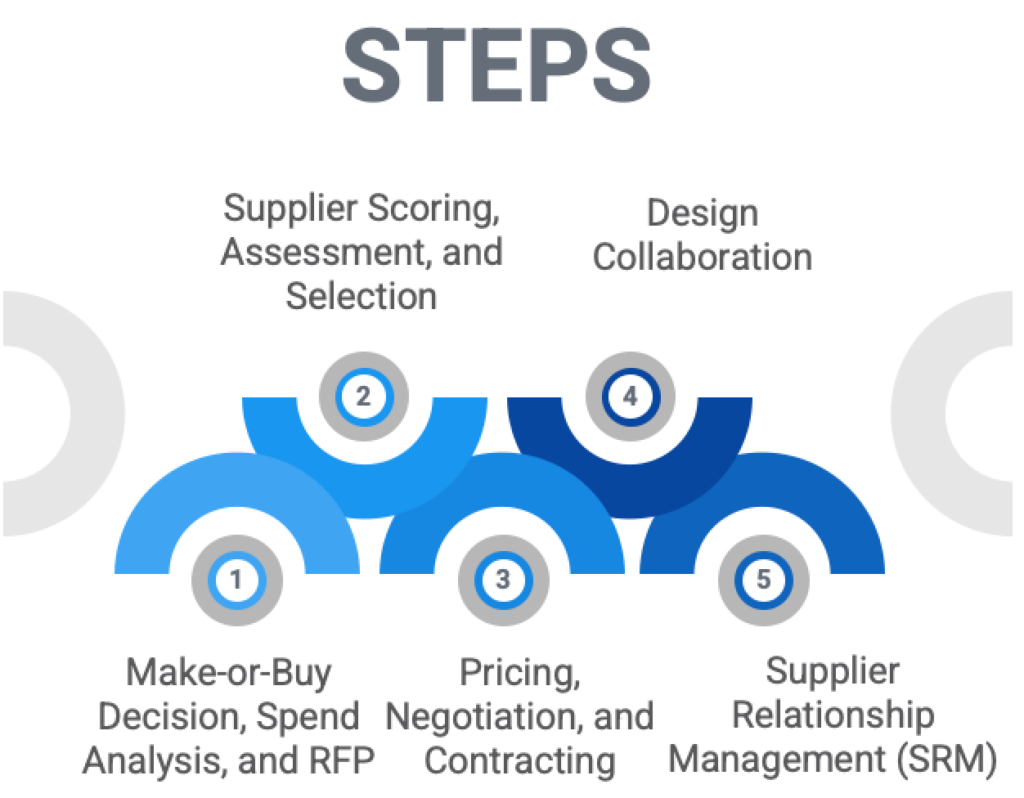The diagram illustrates a potential model outlining the sequential steps that buyers may follow when participating in sourcing activities.
More detailed summaries of each step follow below:
Make-or-buy Decision
The process commences with the crucial make-or-buy decision, primarily within the realm of strategic sourcing. Tactical purchasing and sourcing, on the other hand, tend to be more reactive and involve less in-depth analysis. In order to make a make-or-buy decision, a thorough examination is required, encompassing both financial and strategic justifications, including cost avoidance and spend analysis reviews. Should the decision lean towards buying (or outsourcing), the initial step concludes with the issuance of a request for proposal (RFP) to potential suppliers, if known.
 A make-or-buy decision is the act of deciding whether to produce an item internally or buy it from an outside supplier. Factors to consider in the decision include costs, capacity availability, proprietary and/or specialized knowledge, quality considerations, skill requirements, volume, and timing
A make-or-buy decision is the act of deciding whether to produce an item internally or buy it from an outside supplier. Factors to consider in the decision include costs, capacity availability, proprietary and/or specialized knowledge, quality considerations, skill requirements, volume, and timing
Outsource is defined as the process of having suppliers provide goods and services that were previously provided internally.
Supplier Scoring, Assessment, and Selection
After deciding to purchase a product or service, the next crucial step is evaluating the suppliers, which involves identifying and assessing potential additional suppliers. The objective of this step is to assess the suppliers’ capabilities, initiate discussions on costs, and consider various criteria, such as flexibility and financial stability. Depending on the desired level of collaboration and partnership between the buyer and suppliers, this step can be a complex and time-consuming process. Step 2 culminates in selecting one or multiple suppliers.
Pricing, Negotiation, and Contracting
After identifying a supplier, the buyer must engage in meaningful negotiations pertaining to pricing and other terms. This critical step also involves determining the appropriate type of purchasing contract to effectively manage the relationship. The various contract options will be thoroughly explored in a future session. Step 3 concludes with the creation of the final contract and obtaining the necessary authorization to initiate the actual purchasing process.
Design Collaboration
During step 4, the buyer and supplier collaborate closely in designing the components to be purchased. This crucial step guarantees that design specifications are determined jointly, and any changes are effectively communicated to all involved parties.
Supplier Relationship Management
Even after contracts are signed and purchasing begins, buyers must continue to cultivate relationships with suppliers at all levels. To address this ongoing need, the concept of supplier relationship management (SRM) has emerged as the objective of step 5. SRM leverages computerized applications, such as cloud computing, to streamline processes, conduct analysis, and enhance value-added services. By incorporating these tools from the very beginning, starting with step 1, the aim is to reduce transactional activities. The use of additional tools in SRM promotes collaboration between buying and selling organizations.
The goal of SRM is to structure and support supplier relationships that assist in:
- reducing procurement and excess inventory costs.
- supporting a customer-focused business that delivers product/service customization and quality in the desired time frame.
- improving continuously all levels of product and service processes.

